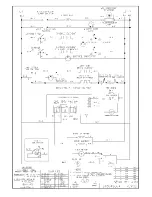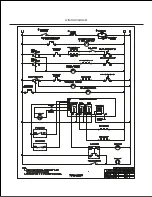
CLEANING AND MAINTANANCE
GB
13
CAUTION !
Do not use oven-cleaning agents for cleaning the ceramic cook-top, since they are
very aggressive and can cause the permanent damage to the cook-top surface.
•
Keep away from the hob heating zones such materials as plastics, or aluminium foil, as they can melt.
In case they have melted onto the surface, remove them immediately from the hob surface (when it is
still warm). Similarly, with the foods with high sugar content: on the surface of the hob, sugar can melt
quickly resulting in permanent stains. The change in the hob surface colour does not affect its proper
functioning.
•
After washing the hob you may put on a preservative e.g. CERA FIX
•
The cookware used for cooking on the ceramic hob should always be clean and dry. Draw special
attention to the cookware bottoms as food residue stuck to them will bake during the next use of the
hob.
6.3
OVEN CLEANING
CAUTION !
1.
Before cleaning you should wait until oven cools down. Hot heaters may cause
burns.
2.
Cleaning the oven with the use of appliances for steam generation under pressure
is not allowed.
3.
It is best to clean the bottom of the oven after each use, not to allow the remains
of food and spots of oil to roast again.
•
The oven interior is covered with ceramic enamel. Models CFF-4VC are equipped with side shields
covered with catalytic enamel (pos. 8 fig. 14), which has self-cleaning properties.
•
During normal usage the interior of the oven becomes heated to high temperatures, in this way the
catalytic enamel can easier absorb emitted vapours.
•
Periodically, particularly after roasting very fat meals it is recommended to make a self-cleaning cycle.
Switch the oven on for an hour and select the maximum temperature (250
0
C). During that time the oven
door should be closed. During self-cleaning process dirt from the catalytic shields will oxidize and
evaporate.
•
After some time the catalytic shields lose their self-cleaning features, and their surface becomes
shining, then you should exchange them.
•
To facilitate cleaning of the oven enamel elements you can remove the oven door
6.3.1
DISASSEMBLY OF THE OVEN DOOR
•
Open the door entirely,
•
Lock hinges on both sides of the door by placing the clamping ring
1
on the catch
2
of the hinge bow
3
(fig. 20),
•
Next grasp the door with both hands, turn it in the closing direction through an angle of 45
0
and take out
the hinges.
Fig. 20
Taking out the oven door
Summary of Contents for CFF-4VC
Page 33: ...GB 16...




































